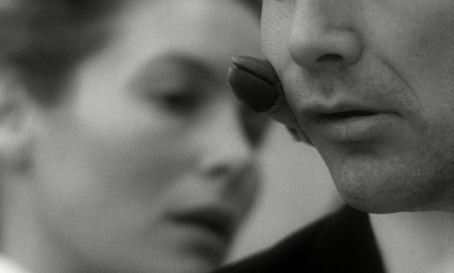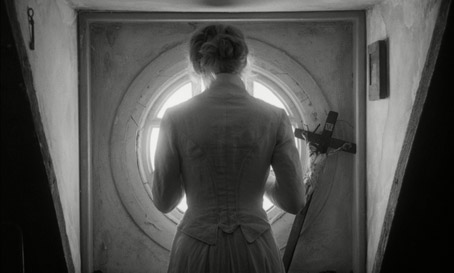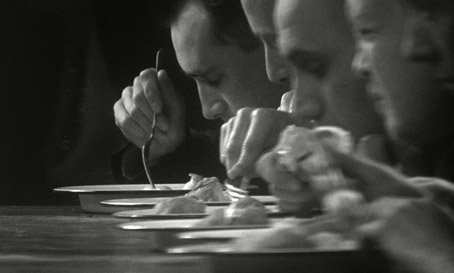|
"Am I living in a fairy tale?" wonders Jakob, the newly arrived student at the Institute Benjamenta, a run-down academy in which men of low self-worth are trained to become servants. Co-run by Herr Benjamenta and his sister Lisa, the Institute seems to exist in a netherworld located somewhere between reality and dreams, a place where corridors can lead inexplicably back on themselves and a chalk circle drawn on a wall can open a doorway to quarters whose apparent splendour can be described but not seen.
The classes themselves are exercises in repetition and unified action, the pupils identifiable by facial characteristics but otherwise largely indistinct from one another, subservient drones operating as a single unthinking and obedient body at the beck and call of their bewitching instructor. The single exception is the attentive Kraus, who appears to have a bit of a thing for Frau Benjamenta, who in turn may or may not be caught up in an incestuous relationship with her brother. She takes quite a shine to the nervous new inmate, granting his request for a room away from his classmates and watching him in class with an interest that evolves into something resembling pained longing. As her fascination with Jakob grows, his presence begins to have an disruptive affect on the stability of the Institute and the relationship between Lisa and her brother.

As this generalised synopsis and the enigmatic title doubtless suggests, Institute Benjamenta, or This Dream People Call Human Life is definitely not one for the multiplex crowd, and the title sequence alone – an entrancing but mystifying series of indistinct, water-based monochrome imagery, elegantly drawn text, and disorientating close-ups with microscopic field-depth – should be enough to send anyone with a hair-trigger dislike for artistic cinema scuttling. But for the rest of us this serves as the stamp of its makers and a seductive appetite-whetter for things to come. For those who didn't already know, Institute Benjamenta was the live-action feature debut of Stephen and Timothy Quay, the twin brother creators of some of the most distinctive, original and imaginative animated short films this side of Jan Svankmajer. If you're new to their work then there are a wealth of goodies just begging for your attention on the BFI's superb The Quay Brothers Short Films 1979-2003 DVD set, my coverage of which provides an outline of my relationship with film surrealism and the work of the Brothers Quay.
Coming back to Benjamenta after a five-year gap, I was particularly struck by that near-unique talent the Quays have of communicating the unexpected beauty of decay and what would elsewhere be regarded as incongruous or grotesque, celebrating elements that other filmmakers go out of their way to remove or disguise. Their seeming aversion to the pristine and the new ensures that every object and surface seems to have its own inbuilt story, and every room is a small museum of divinely mismatched artefacts and fittings. It's an element of their work that for me taps into half-lost memories of childhood, of exploring where I had been repeatedly forbidden to go, of abandoned buildings that had fallen into disrepair and been partially reclaimed and eroded by nature, littered with objects too interesting to be discarded but too infested with rot to be of any practical use. These were the secret places, the magical places, the scary places you only went to by daylight, fearful of the things that lived in the shadows, of the creatures you would hear but never see but that your imagination was happy to give troublesome form to. It's somehow impossible to imagine a Quay brothers film that is set in what we would generally recognise as the modern world, if indeed they are ever located in a specific point in time or even geographical location.
This fascination with sound and imagery over traditional storytelling will see some dismiss Benjamenta as a triumph of style over content, but that seems to be missing the point of a film whose style is as integral to its content as the handycam aesthetics of Cloverfield, if you'll forgive the comparison. Our engagement to Jakob may be limited largely to eavesdropping on his thoughts, but we keenly share his disorientation and uncertainty at his surroundings through the process of experiencing it with him, a total immersion in world that once entered is nigh-on impossible to imagine ever walking away from.

Visually the film is even more striking than I remember, with the BFI's new high definition transfer (more on that below) really showcasing Nic Knowland's beautiful monochrome cinematography, which mixes semi-abstract close-ups with striking formal compositions and diffused, dream-like images where a single element is brought into focus, and plays disorientating games with contrast and image sharpness. Equally beguiling is a soundtrack that feels bonded to the image on a genetic level, with Lech Jankowski's exquisite score working in perfect harmony with Larry Sider's complex sound montage work, and effects that sometimes fly in the face of logic (the noise of a departing tube train is repeatedly woven into the background sound) but nonetheless feel strangely organic to the location and atmosphere. The often literary dialogue, drawn in part, I suspect, from Robert Walser's source novel Jakob von Gunten, can add to the sense that this is an intellectual rather than emotional experience. Yet it also provides a wealth of sometimes unexpected pleasures, from Jakob's philosophical musings and Herr Benjamenta's recollection of meeting Jesus, to Lisa's compelling monologue on her unique understanding of Kraus. There's even a touch of dry lingual humour when the words 'planet' and 'plant' are intriguingly confused.
I'm aware that my enthusiasm for this unique and hauntingly realised film will not be shared by all, and that's fair enough. It's a work whose reputation seems to have grown with time – I remember some negative responses at the time of its initial release that targeted the Quays' handling of actors as live action marionettes. It's a complaint that feels nonsensical given the subtle expressiveness of Mark Rylance's performance as the bemused Jakob (his mid-European accent feels absolutely right), Alice Krige's increasing emotional turmoil as Lisa, and the quietly commanding delivery of Gottfried John as Herr Benjamenta.
For some, the pervading glumness and scene-by-scene storytelling will doubtless prove a little too much to handle, while a search for underlying meanings is also likely to prove a purely subjective experience. The gulag-dressed students and their repetitious conformity, their instruction delivered by a possibly incestuous couple clothed in more aristocratic attire, works for me as a critique of the still lurking ghost of the European class system, while in the accompanying booklet, Samuel Frederick finds meaning in the repeated use of the circular motif. Either way, this is still an intellectually stimulating and artistically thrilling work, and as with the Quay's follow-up feature, The PianoTuner of EarthQuakes, when the elements are working in perfect harmony, as they so often are here, the result borders on the artistically sublime.
The film has been released by the BFI as their first Dual Format release, which contains the film on both DVD and Blu-ray. All of the comments regarding the picture and sound below refer to the Blu-ray version.
The film was transferred at the correct aspect ratio of 1.66:1 in high definition from a 35mm finegrain and a low contrast 35mm print, both held by Channel Four, and HD-DVNR and MTI systems were used to restore the picture, remove dirt and scratches and improve picture stability. Actually judging the quality of the HD image is far from a straightforward task. The film's visual style incorporates variations in contrast, image diffusion, and a focus range that is sometimes measurable in microns, resulting in whole sequences that are indistinct and unfocussed and whose contrast density can vary from shot to shot, all of which is intentional and very much part of the film's aesthetic. To correctly judge the transfer quality you need to look at the unfiltered shots, those that seem to relish in the texture of surfaces and materials contained within, and here the image shines, boasting a sharpness, level of detail and tonal richness that leave all previous home video versions of the film standing. Prime examples include just about any scene set in Herr Benjamenta's office; the detail on skin and hair on big close-ups of faces or hands; the lettering of signs and the wood grain of frames; the broken symmetry of the image Lisa framed against a circular window in Jakob's room; the sweat on the sleeping Lisa's face. You'll find plenty more. A lovely transfer.

The DTS-HD Master Audio mono soundtrack has been transferred from the original master mix mags and any damage here has also been carefully cleaned up. The clarity is excellent, allowing even the almost subliminal sound effects to make their mark and doing full justice to Lech Jankowski's score. Both the sound and picture were restored and transferred under the supervision of the Quay Brothers and the film's director of photography Nic Knowland.
All of the extras on the Blu-ray are in 1080p HD.
Inside the Institute: an in-between world (30:59)
A welcome and hugely informative look back and the making of the film, built around interviews with the Quay brothers, scriptwriter Alan Passes, actors Alice Krige and Mark Rylance, cinematographer Nic Knowland and editor and sound montage designer Larry Sider. I'm sure the Quays have become chattier in interview in recent years, and are here very open about the process of the film's development and construction, ably assisted by Passes and leaving the more offbeat recollections to the actors. Knowland and Sider provide some valuable information about their contributions and the Quays' very specific approach to the film's unique look and sound. Having written the review before watching this, I was pleased to hear several of my suppositions about meaning and intent confirmed.
Trailer (1:21)
An atmospheric trailer that makes a virtue of the film's strangeness but is constructed entirely from the its few animated elements, suggesting a certain nervousness about marketing these celebrated animators as fledgling live action directors.
The Comb (18:05)
Quay fans will need no introduction to what remains one of their most disquieting and narratively ambiguous works. Like Benjamenta, it's drawn from the written work of Robert Walser and features a number of signature Quay elements, including those creepy blank-faced dolls and a sleeping woman with a finger that appears to be under external control. Visually it's an extraordinary work, a trip into the darker side of fairytale subconscious and true surrealist film in the very best sense of the term. The high definition transfer does highlight some unexpected variations in grain, and the use of shallow focus can make it tricky to appreciate the upgrade at times, but an upgrade it definitely is, providing a richer and more detailed picture than any DVD version, something particularly evident on a room-dominating Plasma screen.

Songs for Dead Children (24:02)
Now here's a curiosity, a series of animated pieces set to a selection of songs by The King's Singers. Those of you of a younger age may not be aware of these fellows (there are still going strong, I gather, albeit with a modified line-up), a vocal ensemble group formed at Cambridge University who came to prominence in the 70s singing cappella versions of well known pop songs and whose facial animation during performance sometimes bordered on parody. Their work here provides a structurally complex (you've never heard Oranges and Lemons sung like it is here) and melancholic basis for one of the Quays' most abstract and unsettling works to date. There are plenty of familiar Quay elements on display, including blank-eyed dolls, small and rapidly oscillating objects, a wooden anatomical model (a fascinating if rather creepy creation), diffused imagery, and a sleeping figure whose arm is under independent control, and in terms of its light levels this is probably the brothers' darkest film to date.
Eurydice, She so Beloved (11:05)
A live action musical interpretation Orpheus' quest to rescue his dead lover Eurydice from Hades, bristling with extraordinary monochrome imagery, into which colour quietly bleeds in the later stages. An appreciation of the music is probably required to get the most out of the film, despite its visual splendour, and it's not as instantly recognisable as a Quay Brothers work as the two preceding shorts.
Booklet
A typically fine accompanying booklet that includes a detailed essay by Samuel Frederick on the Quays and author Robert Walser, a concise biography of the brothers by Michael Brooke, a most engaging letter sent to the brothers earlier this year by their regular producer Keith Griffiths, a biography of Griffiths by the good Mr. Brooke, notes on Lech Jankowski's music score, feature film credits, and a piece on photographer Jill Furmanovsky, some of whose production photographs are also included.
A final extra, On the Set of Institute Benjamenta (2000, 16 mins) is not on the Blu-ray review disc and is included on the DVD only.
Guaranteed not to be everyone's cup of tea, and a few of the more hardcore fans of the Quays' animation may liken their move to live action to Bob Dylan going electric. But for me Institute Benjamenta just gets better and better with age, a poetic, semi-abstract and richly layered journey to an in-between world, one shaped as much by dark fairy-tales and the legacy of surrealism as the writings of Walser. Despite minimal use of their signature animation, this is still much a Quay Brothers film, and for my money not only one of their most handsomely realised cinematic achievements, but also one of the most visually and aurally beautiful works of late twentieth century cinema. The BFI Blu-ray lives up to all my expectations and meets the challenges set by the film's unique aesthetic head on. For Quay Brothers devotees, this is an absolute must-have.
|